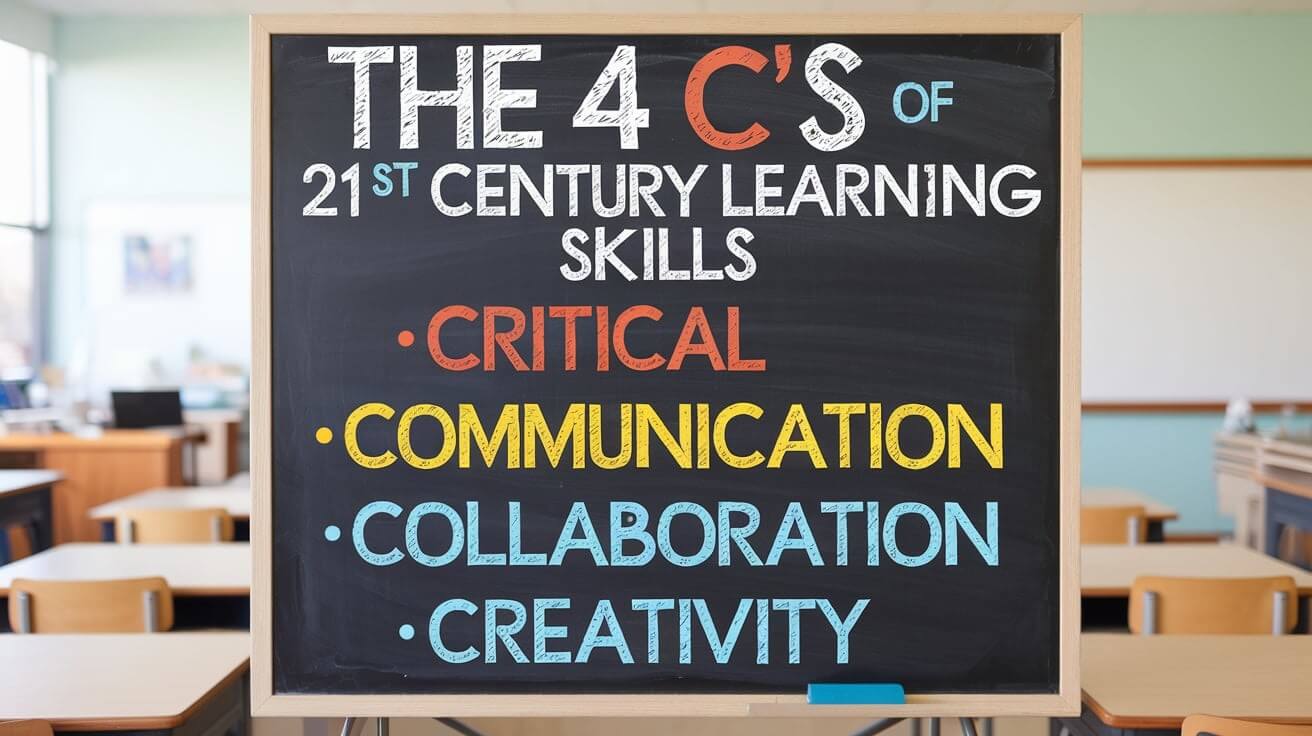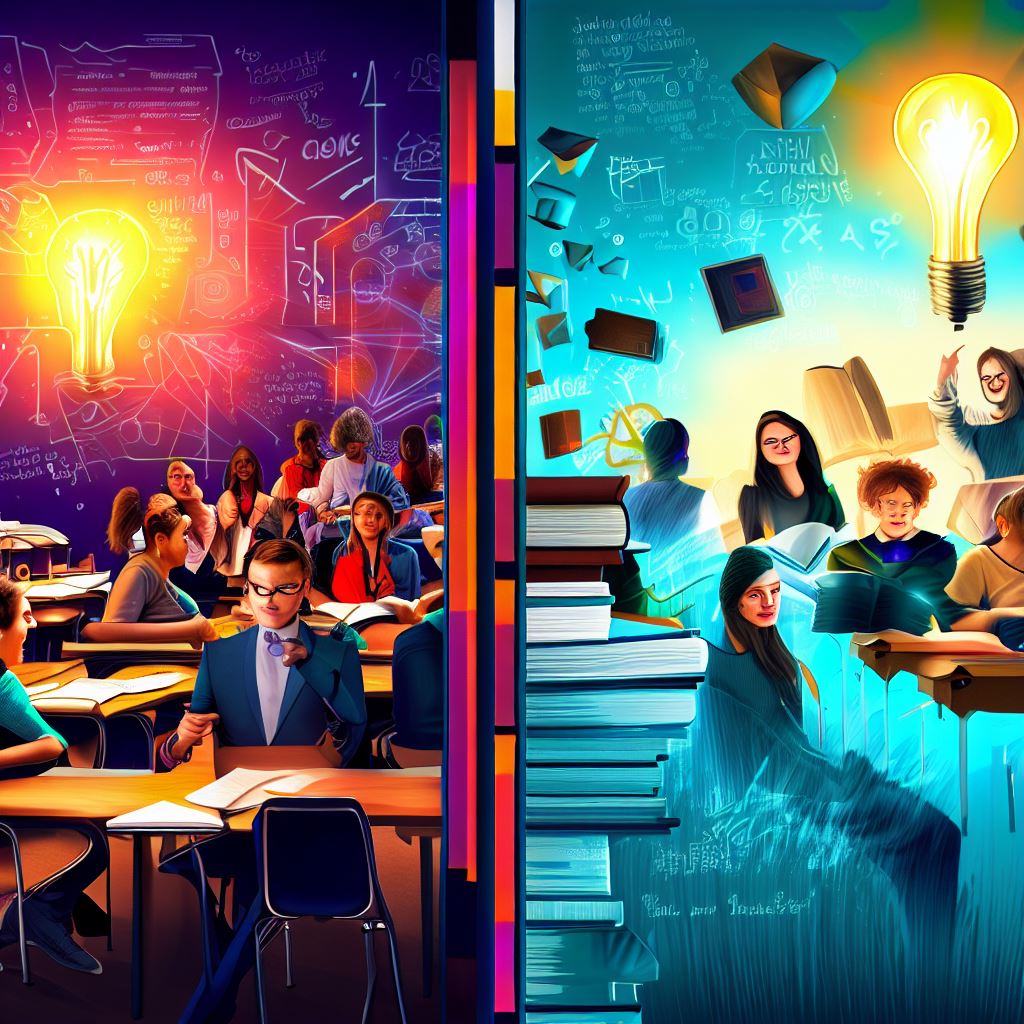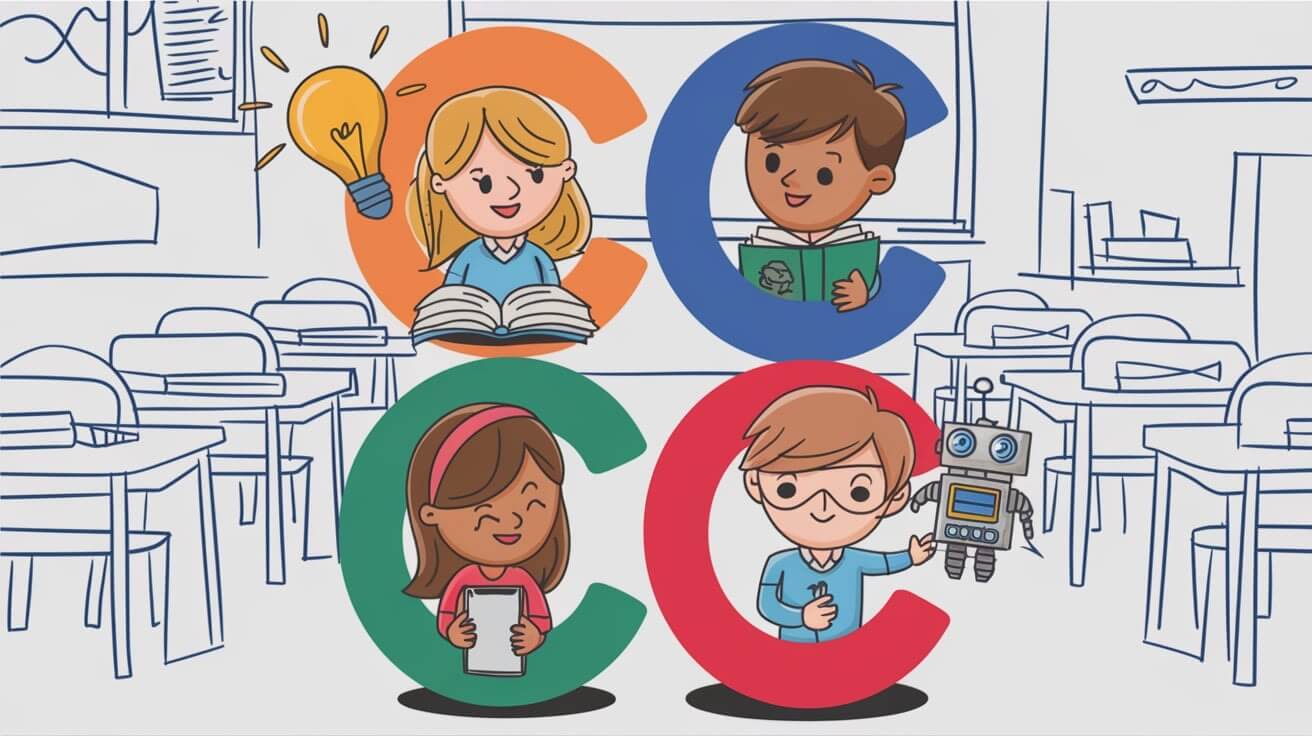
How do we prepare today's students for tomorrow's challenges? The answer lies in what educators call the 4Cs of 21st-century learning: Critical Thinking, Communication, Collaboration, and Creativity. These skills go beyond traditional academics, shaping individuals who can adapt, innovate, and contribute meaningfully to society.
Imagine a classroom where students solve real-world problems, work as a team to brainstorm solutions, and present their ideas confidently. That's the power of the 4Cs. Whether you're a teacher, parent, or student, understanding these skills—and how to cultivate them—can transform learning experiences and outcomes.
This article explores what the 4Cs mean, why they matter, and how educators can effectively integrate them into classrooms. Along the way, you'll find relatable examples, actionable strategies, and insights backed by research.
What Are the 4Cs of 21st-Century Learning?

Critical Thinking, Communication, Collaboration, and Creativity—often called the 4Cs—are vital skills that help individuals effectively tackle challenges and opportunities in today's ever-evolving world.
These skills complement traditional education by focusing on students' abilities to succeed in life and work. Explore the 4Cs further to understand their significance, practical applications, and real-world benefits.
1. Critical Thinking

Critical thinking is the cornerstone of problem-solving and decision-making. It empowers students to analyze information, identify patterns, and draw logical conclusions based on evidence. Unlike rote memorization, critical thinking encourages curiosity and skepticism, urging students to ask "why" and "how" rather than just accepting facts as presented.
Imagine a history class where students explore the causes of the Industrial Revolution. Instead of memorizing dates or events, they evaluate primary and secondary sources, compare varying historical interpretations, and discuss the social and economic impacts. This process teaches them historical content and fosters analytical skills they can apply in other contexts, such as evaluating news articles or interpreting scientific studies.
Teachers can use tools like concept maps to help students visualize their thoughts, breaking down complex ideas into manageable parts. Additionally, assigning open-ended projects allows students to explore multiple solutions to a single problem.
A study featured in Educational Researcher reveals that classrooms that emphasize critical thinking see a 25% increase in student engagement and a significant improvement in academic performance. This skill equips students to thrive in problem-solving roles across engineering and healthcare industries.
Critical thinking isn't just an academic skill; it's a life skill. For example, a student might apply this skill to evaluate the advantages and disadvantages of selecting a university or assess the reliability of a news source. By questioning and evaluating, students become more informed citizens capable of making sound decisions.
2. Communication

Communication is more than speaking or writing; it's about ensuring your message is understood by others and being able to understand theirs. It includes verbal, non-verbal, and digital communication and the often-overlooked skill of active listening.
Effective communication bridges gaps between individuals and groups. Whether presenting an idea, drafting a report, or negotiating in a team, expressing oneself clearly and confidently is vital.
Teachers can introduce activities like group presentations, debates, or podcast creation to enhance communication skills. These activities improve public speaking and teach students how to structure their ideas logically and respond to feedback constructively.
A teacher assigns students to create a podcast about climate change. Each student takes on a role, such as researching data, writing a script, or recording audio. This activity teaches students to articulate their thoughts, use persuasive language, and ensure clarity.
The National Association of Colleges and Employers (NACE) in the USA reported that 86% of employers consider communication one of the most essential skills when hiring decisions. This statistic underscores the importance of communication not just in school but also in professional settings.
Active listening is an effective communication component. When students genuinely listen to others, they gain insights, build empathy, and improve their ability to respond thoughtfully. For example, students who listen actively during peer feedback sessions can provide more meaningful critiques.
In today's digital age, mastering tools like email, video conferencing, and collaborative platforms is just as essential. Encouraging students to participate in online discussions or create digital presentations prepares them for modern workplaces.
3. Collaboration

Collaboration teaches students how to work effectively with others, combine strengths, share responsibilities, and achieve common goals. It fosters a sense of teamwork and empathy, preparing students for environments where cooperation is vital.
In a STEM project, students design a solar-powered device. One student handles the technical research, another focuses on engineering, and a third manages the presentation. This activity mirrors workplace dynamics, where diverse expertise comes together to solve problems.
Collaboration encourages students to respect different viewpoints, resolve conflicts amicably, and share accountability for outcomes. These experiences enhance social skills and build confidence in their ability to contribute meaningfully to group efforts.
Teachers can implement peer review sessions, where students critique and improve each other's work. This reinforces the importance of constructive feedback and teaches students to appreciate diverse perspectives.
A study by Edutopia found that students who engage in regular collaborative learning activities improve their interpersonal skills by 20% and demonstrate higher engagement in academic tasks.
Platforms like Google Workspace or Microsoft Teams enable students to collaborate on projects outside the classroom. These tools mirror the collaborative software commonly used in professional settings, giving students a head start on workplace preparedness.
Collaboration is essential in industries like healthcare, engineering, and technology. For example, doctors, nurses, and specialists must collaborate to ensure patient care. Students build a foundation for success in such environments by practicing teamwork in school.
4. Creativity

Creativity isn't confined to artistic pursuits—it's about generating new ideas, finding innovative solutions, and approaching problems from unique angles. It fuels innovation, making it an invaluable skill across industries.
A teacher in California introduced a "design your city" project in which students planned sustainable and eco-friendly urban layouts. This activity combined creativity with practical problem-solving, as students had to consider factors like energy efficiency, population density, and green spaces.
Encourage students to brainstorm solutions without fear of failure. Suppose, in a science class, allow them to test unconventional ideas during experiments, fostering an environment where creativity thrives.
Adobe's Creativity in Education Report reveals that 78% of educators believe creativity enhances students' critical thinking and problem-solving abilities. This shows how intertwined creativity is with other essential skills.
Creativity is crucial in fields like technology (designing user-friendly apps), business (developing marketing strategies), and engineering (inventing new materials). Schools can nurture this skill by integrating cross-disciplinary projects that require students to connect the dots between seemingly unrelated subjects.
Beyond academics, creativity is a life skill. A student might use creative problem-solving to organize a community fundraiser or resolve a conflict with friends. By nurturing creativity, educators help students.
Why the 4Cs Are Essential in Education

With their heavy reliance on memorization and standardized testing, traditional education methods often fail to prepare students for the complexities and unpredictability of modern life. Today's world demands individuals who can think critically, communicate effectively, collaborate seamlessly, and approach problems with creativity. The 4Cs—Critical Thinking, Communication, Collaboration, and Creativity—fill this gap by fostering adaptability, innovation, and teamwork, essential for professional success and navigating everyday challenges.
Relevance to Careers
Modern workplaces have evolved dramatically, and employers prioritize soft skills alongside technical expertise. According to a Deloitte report, 92% of executives view skills like communication, teamwork, and adaptability as equally crucial as specialized knowledge. This change highlights the increasing significance of the 4Cs in developing a balanced and adaptable workforce.
Consider the healthcare industry. A nurse, for instance, requires more than just technical proficiency. In high-pressure situations, they must communicate clearly with patients, collaborate effectively with doctors and specialists, and think critically to make quick, informed decisions. These abilities enhance individual performance and improve patient outcomes, illustrating how the 4Cs are indispensable across diverse fields.
In industries like technology and business, creativity and collaboration often drive innovation. Teams that work well together can develop groundbreaking solutions, whether designing user-friendly software or launching a new marketing campaign. Employers increasingly value employees who can connect ideas, think beyond conventional boundaries, and bring fresh perspectives.
Impact on Lifelong Learning
Beyond career readiness, the 4Cs are crucial in cultivating lifelong learners. Thinking critically and adapting to new information is particularly important in a world where technology and industries constantly evolve. Creativity enables individuals to approach problems flexibly, while collaboration builds the interpersonal skills for navigating personal and professional relationships.
Imagine someone in their 40s learning a new coding language to switch careers or adapt to changes in their current role. This transition would be significantly more manageable with the basic skills of critical thinking, problem-solving, and adaptability developed through the 4Cs.
The 4Cs also foster resilience. Lifelong learners with these skills are better prepared to overcome obstacles, embrace change, and seek continuous self-improvement. For instance, as artificial intelligence and automation reshape the job market, individuals who collaborate across disciplines, communicate effectively, and think creatively will have a competitive edge.
A Balanced Future
Ultimately, the 4Cs create a bridge between education and real-world demands, ensuring students are academically proficient and ready to tackle the complexities of life and work. By adjusting these skills into the educational framework, schools can transform students into adaptable, innovative, and collaborative individuals prepared for the future.
Strategies for Teaching the 4Cs
Teaching the 4Cs—Critical Thinking, Communication, Collaboration, and Creativity—requires intentional strategies that actively engage students and encourage them to practice these skills meaningfully. Educators can integrate these approaches into everyday classroom activities, ensuring learning remains dynamic, relevant, and student-centered.
1. Critical Thinking
Critical thinking develops when students are challenged to analyze information, draw logical conclusions, and evaluate evidence. Two effective methods for fostering this skill are:
Socratic Seminars:
By posing open-ended questions like "What makes an argument convincing?" or "How does this theory apply to current events?" educators can create a space for structured debates. This encourages students to think critically, analyze multiple perspectives, and defend their reasoning. For instance, a literature class might explore whether a character's actions were justified, prompting students to cite textual evidence and evaluate opposing viewpoints.
Problem-Based Learning (PBL):
Real-world problems such as designing a water filtration system or planning a sustainable city challenge students to research, brainstorm solutions, and test their ideas. In science classes, PBL could involve analyzing the environmental impact of renewable energy sources, combining critical thinking with hands-on learning.
2. Communication
Good communication skills go beyond speaking and writing; they also include listening and adapting one's message to different audiences. Here are two strategies to refine this skill:
Debates:
Debates on contemporary topics—like the pros and cons of social media—help students articulate their viewpoints while learning to listen and respond thoughtfully to others' arguments. This activity also sharpens critical listening, as students must analyze their peers' reasoning and counter with evidence-based points.
Writing Workshops:
These sessions encourage students to craft essays, personal narratives, or research reports. By emphasizing structure, clarity, and tone, educators help students refine their written communication. Peer editing can further enhance these workshops, teaching students to give and receive constructive feedback.
3. Collaboration
Collaboration teaches students to work together, respect diverse perspectives, and solve problems collectively. These strategies make teamwork both fun and educational:
Group Challenges:
Activities like escape rooms or scavenger hunts engage students in a shared goal, requiring them to delegate tasks, strategize, and solve problems as a team. For example, in a geography class, students could collaborate to "unlock" clues about different countries, blending collaboration with academic learning.
Peer Reviews:
Peer assessments allow students to constructively critique each other's work, fostering collaboration and critical thinking. For instance, in an art class, students might review and discuss their peers' sketches, offering constructive feedback on technique and composition.
4. Creativity
Creativity thrives when students are given opportunities to experiment, innovate, and express their ideas without fear of failure. These methods help foster a creative mindset:
Cross-Disciplinary Projects:
Combining subjects like art and science allows students to approach problems from different angles. For instance, creating infographics that explain climate change enhances creativity and reinforces communication and critical thinking skills.
Brainstorming Sessions:
Dedicating time for idea-sharing encourages students to think beyond conventional boundaries. Whether brainstorming solutions for environmental issues or designing prototypes in a robotics class, these sessions foster an environment where innovation flourishes.
Enhancing the Strategies
These ways can be tailored to meet the needs of different classrooms and age levels. For example, younger students might collaborate through group art projects. In comparison, older students could tackle more complex problem-solving scenarios like debating ethical dilemmas in artificial intelligence. Integrating technology—such as collaborative tools like Google Docs or brainstorming apps like Padlet—further enhances these activities, making them more engaging and relevant to the digital age.
Moreover, educators should model the 4Cs in their teaching methods. By demonstrating critical thinking through thought-provoking questions, effective communication by articulating ideas clearly, collaboration with students during group tasks, and creativity by encouraging diverse solutions, teachers can inspire their students to embrace these essential skills.
Overcoming Challenges in Implementing the 4Cs
Integrating the 4Cs—Critical Thinking, Communication, Collaboration, and Creativity—into educational practices offers immense benefits but presents several challenges. Addressing these obstacles requires thoughtful solutions that involve educators, parents, and policymakers while leveraging available resources to make these skills accessible to all students.
Challenge 1: Resistance to Change
Resistance to change often stems from unfamiliarity or fear of deviating from traditional teaching methods. Many educators and parents have grown accustomed to conventional approaches centered around lectures and rote learning, making it difficult to accept new practices focused on fostering creativity and collaboration.
Hosting workshops and hands-on training sessions for educators and parents can bridge this gap. These workshops should demonstrate the practical benefits of 4C-focused teaching by showcasing real-life examples, case studies, and evidence of improved student outcomes. For instance, a workshop might highlight how collaborative group projects enhance teamwork and improve academic performance. Engaging parents in these sessions helps them understand the long-term value of equipping their children with 21st-century skills, fostering support for these initiatives.
Challenge 2: Resource Limitations
Limited resources, particularly in underfunded schools, can hinder the implementation of creative and collaborative learning experiences. Teachers often need access to the tools, materials, or training to design engaging 4C-based activities.
Technology can play an innovative role in overcoming resource constraints. Free online tools like Google Workspace, Canva, and Kahoot provide cost-effective ways to support creative and collaborative projects. For example, Google Docs enables real-time collaboration, allowing students to work together seamlessly outside the classroom. Canva provides an accessible platform for creating visually engaging presentations and infographics. At the same time, Kahoot makes learning interactive and fun through gamified quizzes. Educators can also explore open educational resources (OERs) that offer free lesson plans, activities, and materials designed to promote the 4Cs.
Challenge 3: Emphasis on Standardized Testing
The current emphasis on standardized testing often discourages the integration of the 4Cs, as these assessments prioritize memorization and factual recall over skills like critical thinking and creativity. This focus can leave little room for innovative teaching approaches.
Advocacy for alternative assessment methods is essential to addressing this challenge. Project-based evaluations, for example, provide a more holistic measure of a student's abilities. These assessments involve designing a sustainable city, presenting a business plan, or solving a real-world problem, requiring students to demonstrate critical thinking, effective communication, teamwork, and creativity. Educators and administrators can pilot such assessments alongside traditional exams to showcase their effectiveness in evaluating a broader range of skills. Additionally, partnerships with organizations that support education reform can amplify these efforts, helping to shift the narrative toward valuing diverse competencies over test scores alone.
Case Studies of Successful 4Cs Integration
Singapore's Education Reforms:
Singapore has created a system where students excel in collaboration and communication by focusing on project-based learning.
Finland's Creativity-Driven Curriculum:
Finland incorporates hands-on, interdisciplinary activities that prioritize creativity and critical thinking.
Montessori Schools:
These institutions emphasize self-directed learning, helping students develop the 4Cs organically.
Key Takeaways
-
The 4Cs—Critical Thinking, Communication, Collaboration, and Creativity—are foundational for modern education.
-
Practical strategies like group projects, debates, and design-thinking workshops make these skills accessible to students.
-
Overcoming challenges requires systemic changes, teacher training, and innovative assessment models.
Conclusion
The 4Cs represent a shift from passive learning to active engagement, preparing students for real-world challenges. By embracing these skills, educators can inspire the next generation of thinkers, leaders, and innovators. Whether it's a group project that teaches collaboration or a debate that sharpens communication, every step toward integrating the 4Cs is a step toward meaningful education.
References:
-
Adobe. (2019). Creativity in Education Report.
-
Deloitte Insights. (2019). Future of Work Trends.
-
Edutopia. (2020). Collaborative Learning Benefits.
-
National Association of Colleges and Employers. (2020). Employability Skills Survey.
-
World Economic Forum. (2020). Future of Jobs Report.
Also Read:
Self-Learning Skills: Proven Techniques for Personal and Professional Growth
4Cs of 21st-Century Learning Skills in Education
How to Develop Critical Thinking Skills in the 21st Century
4 C's of 21st-Century Learning Skills
Essential Learning Skills for the 21st Century
Learning Skills for Students: Your Guide to Academic Success
Key Learning Skills for Academic Success: Effective Strategies
18 New Skills to Learn for Professional Growth
Critical Thinking Skills Can Improve Reading
Top 10 Critical Thinking Skills to Develop for Success
Learning Skills




